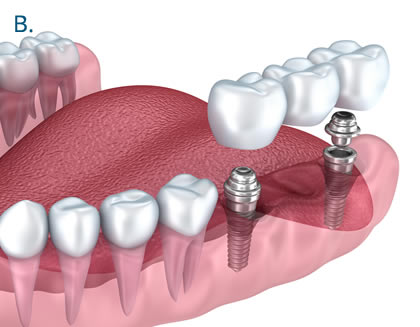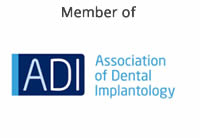Dental Implants
The ultimate level of Implant Dentistry
Replace Your Missing Teeth
Missing teeth not only cause patients to hold their hand over their mouth when they smile, but also prevent many people eating in a way that is enjoyable.
Patients often find they are last to finish meals and can't order what they want off of the menu in their favourite restaurant.
Replacing missing teeth with dental implants gives a permanent solution, restoring your bite, appearance and confidence.
For patients that are nervous of the dentist and having dental implant is placed, we offer both 'happy gas' and intravenous 'twilight' sedation. Both of these options allow you to completely relax and drift off into your own ' twilight' world.
What Is the Dental Implant Process?
The process starts with a free initial assessment with Dr Dargahi, this allows you to talk about your concerns and he can let you know if implants might be a possibility. If you like what you hear the next stage would be to have a dental implant initial consultation, this would include a CT scan to ensure you are clinically suitable.
We would then begin a process of diagnostics, working out how many implants you might need, where they would go and how they would be restored with teeth.
The implants would then be placed and you will be provided with temporary teeth whilst the implants heal.
After this the final teeth will be placed on top of the dental implants. The whole process usually takes between 3-6 months.
Request a Free Assessment
An opportunity to meet with Dr Dargahi who will listen to your concerns and explain your options for treatment to achieve a straighter smile. If you like what you hear you will then be invited for a full new patient clinical consultation.
5 Star Google Reviews



Free Information Pack
download a free information pack
A 36 page report full of the most useful information, ideal if you’re thinking about replacing missing teeth, find out:
- The costs and lowest price alternatives
- Your options and choices for treatment
- Are you suitable for treatment?
- Can dental implants be used as an alternative to root canal treatment?
- What happens if you smoke?
- How many implants might you need?
- Plus lots more…

The Straumann® Dental implant System

With its roots in Swiss precision engineering and clinical excellence, the Straumann® Dental lmplant System is renowned for its exceptional quality and reliability.
It is one of the most extensively scientifically documented implant systems in the world.

A - Dental Implants supporting overdentures
 B - Dental Implants supporting a bridge
B - Dental Implants supporting a bridge

C - Dental Implant to replace a single missing tooth
CT Scanner

Our decision to introduce cone beam technology was initially based on the knowledge that the state-of-the-art in implant treatment planning involved the use of three-dimensional imaging;
We selected the Sirona Orthophos XG 3D because of its accuracy, and its ability to take both a two-dimensional panoramic as well as a three-dimensional cone beam image. As an instrument for treatment planning implant cases, it exceeded all of our expectations, with the added bonus of being able to take more cases from diagnosis to completion.
3D technology is becoming increasingly well established in dental practices around the world. For more precise diagnoses and explanations of treatment, 3D X-rays offers a number of advantages.
We have found that 3-D imaging became indispensable in a wide range of dental diagnosis and treatment planning, to the point that there are many cases today where we cannot even imagine understanding how to best help a patient without the use of the third dimension.

We found applications in endodontics with visualizing fractured roots, periapical pathology, and accessory canals; in treatment planning for the extraction of third molars in proximity to the mandibular nerve; in diagnosing pathology of all types; in understanding the cause of previously undiagnosed pain; in visualizing sinus pathology; in understanding the ethology of temporomandibular joint dysfunctions; and in diagnosing the true extent of periodontal pathology and disease in localized areas. And while we do not practice orthodontics, we are well aware of the orthodontic applications of 3-D imaging.
In implant treatment planning, we have come to hold the strong opinion that the standard of care today in implant dentistry is to recommend 3-D imaging for implants for nearly every patient, and because of this it would be poor practice to do implants without using 3-D imaging.
This philosophy has quickly expanded into all phases of our practice of dentistry.
The presence of this technology has forever altered the standard of care in our profession with respect to diagnosis and treatment planning. 3-D cone beam imaging has raised the bar and redefined the standard of care for many areas of dental practice.



